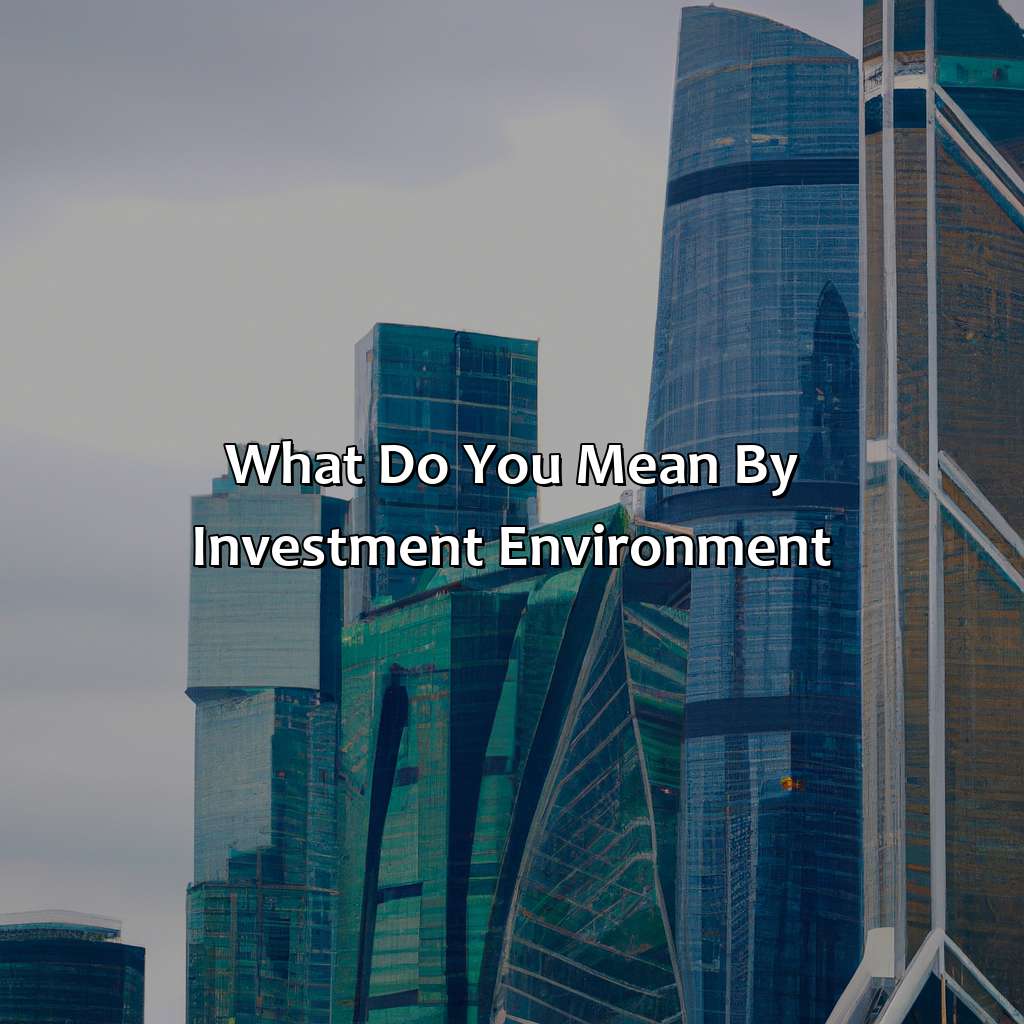What Do You Mean By Investment Environment?
Key Takeaway:
- The investment environment is defined as the factors that influence investment opportunities, investor confidence, and investment risk, such as political, economic, market, social, and technological components.
- Government policies, economic indicators, market conditions, social factors, and technological advancements are all important factors to evaluate when assessing the investment environment.
- The investment environment plays a crucial role in determining the success of investments and businesses, as it affects the flow of capital, the profitability of investments, and the overall economic growth of a country or region.
Are you confused as to what investment environment is all about? Have you been looking for ways to make the best out of your investments? This article will provide you the answers you need. Focusing on investment strategies, tax policies, and government regulations, this article will help you make informed decisions. Get ready to unlock the meaning of investment environment!
Definition of Investment Environment
Investment Environment refers to the conditions and factors that affect investors and their investment decisions. These factors include economic conditions, political stability, government policies, market trends, competition, and technological advancements. The investment environment is critical for investors as it determines the risks associated with investing and the potential returns. These factors can create opportunities or challenges for investors.
The economic conditions, such as inflation, interest rates, and exchange rates, can affect the investment environment. The political environment, including government stability and regulation, also plays a crucial role in the investment climate. Market trends and competition often determine the viability of investments, while technological advancements can create new investment opportunities.
It is important to note that the investment environment is dynamic and constantly changing. Investors need to be aware of the changes and adapt their strategies accordingly. Successful investors regularly assess the investment environment and adjust their investments to maximize returns while minimizing risks.
In a real-life example, the 2008 financial crisis represented a significant shift in the investment environment, which had dramatic effects on global investment practices. The crisis highlighted the importance of understanding the investment environment and the inherent risks associated with investing. As a result, investors focused more on portfolio diversification and risk management strategies, rather than seeking high returns at any cost.
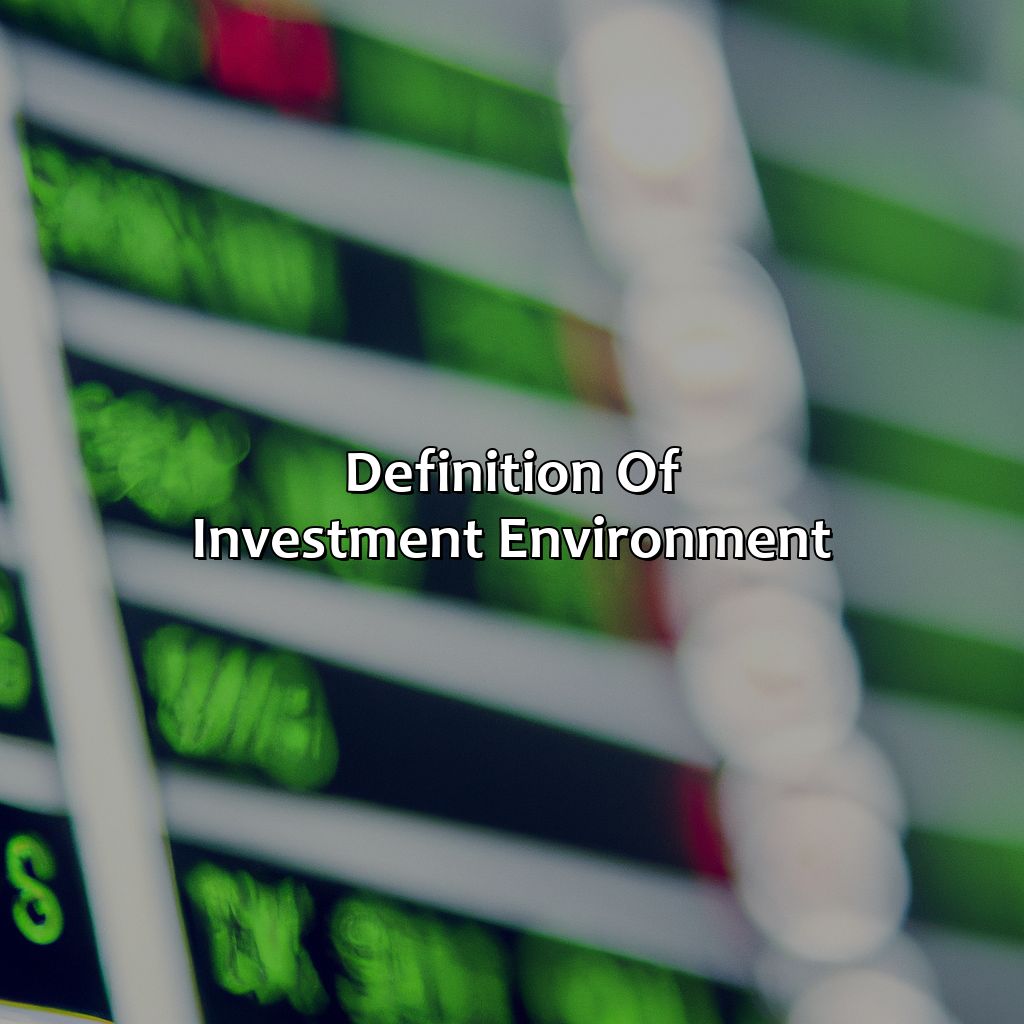
Image credits: retiregenz.com by James Washington
Components of Investment Environment
To comprehend investment environment elements, you must know political, economic, market, social, and technological factors. Examining these factors can help you determine if investing in a certain area is viable and profitable. Get familiar with how each factor can influence investment decisions.
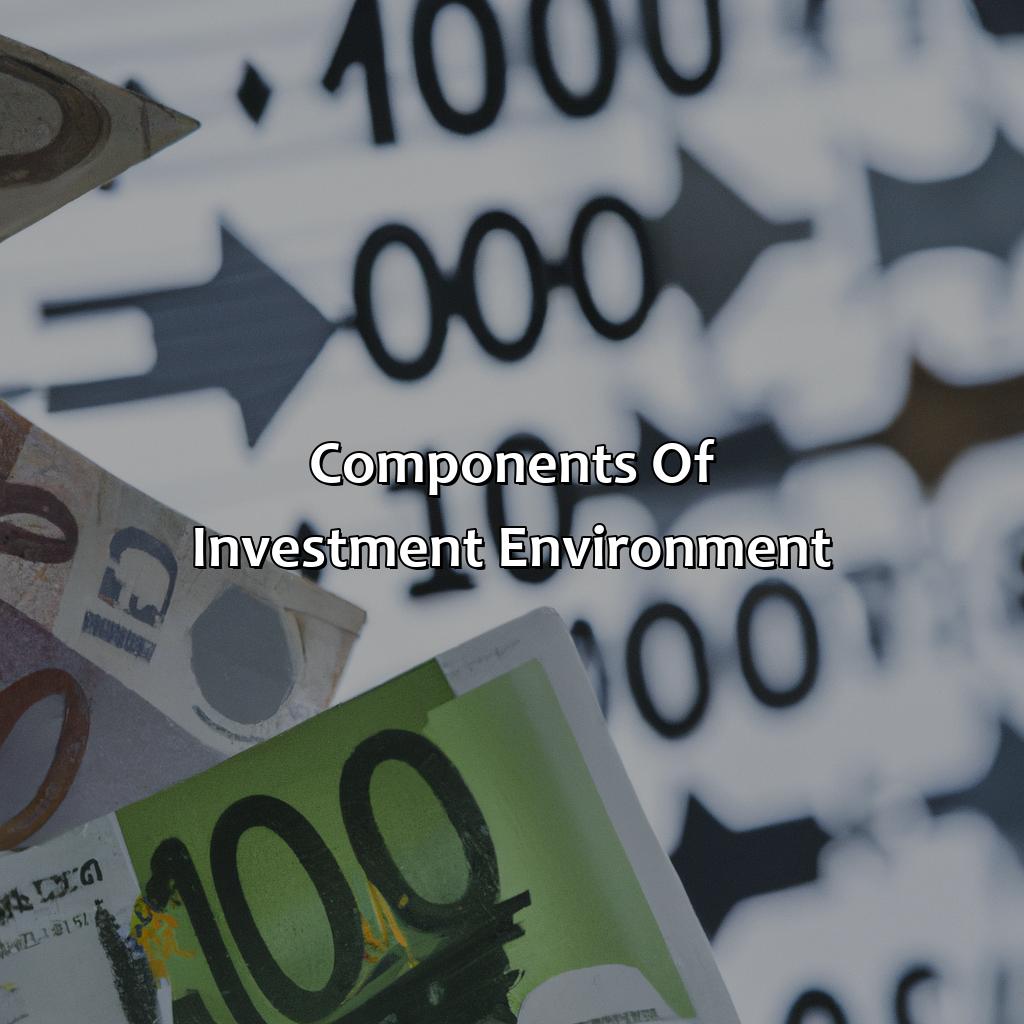
Image credits: retiregenz.com by Harry Washington
Political
In the investment environment, the factors that determine the returns also include the political landscape. Political stability or instability can create favorable or unfavorable conditions for investors. A manipulative state with constantly changing regulations and policies, threats of nationalization and expropriation, high taxes, and corruption hinders business development. On the other hand, a government that encourages investment by offering tax benefits, debt facilities and subsidies along with maintaining a stable regulatory environment is ideal for investments.
Another factor that affects Political stability is geopolitical risk which includes events such as war, terrorism or natural disasters. Additionally, the relationship between countries’ leaders is also important to consider as tensions between two nations could lead to sanctions and other trade restrictions.
International organizations such as World Bank and IMF keep an eye on political instability in their member countries while evaluating the investment climate.
According to Forbes magazine’s report from January 2021, “Political risks were cited as the number one concern among 1,298 companies surveyed in all regions of the world.”
Investing in the economy is like going on a rollercoaster ride – it’s exciting, terrifying, and you never know when you’re going to lose your lunch.
Economic
In the investment environment, ‘Economic’ refers to various factors within the economy that impact investment decisions. These include macroeconomic indicators, policies set by government agencies, and business cycles.
- Macroeconomic Indicators: These are measures that provide insight into the health of the economy such as Gross Domestic Product (GDP), inflation rates, and employment levels.
- Government Policies: Economic policies such as tax laws, trade agreements, and regulations can significantly affect investment opportunities.
- Business Cycles: The natural progression of the economy from periods of growth to decline can impact an investor’s decision-making process.
- Market Conditions: Trends in financial markets also influence investments such as interest rates and exchange rates.
- Capital Flows: The movement of capital in and out of a country can be impacted by economic conditions both domestically and internationally.
Investment opportunities can be highly influenced by economic factors within the investment environment. By using a thorough analysis of these elements investors can make informed decisions based on market trends.
In today’s hyper-connected global economy, fluctuations within economies worldwide create far-reaching effects beyond their borders. Investment in developing countries with strong economic growth potential is becoming an increasingly popular choice due to its potentially high yields.
Following the US housing bubble crisis in 2008, many investors became wary specifically focused on macroeconomic indicators when making investment decisions. Since then investors are focusing more attention on tracking all impacting variables so they can analyze possible obstacles or opportunities for investments.
Investing in the stock market is like a rollercoaster: it’s a wild ride full of ups and downs, but the thrill makes it all worth it.
Market
Investment opportunities are heavily determined by the dynamic and ever-changing economic sphere, commonly referred to as the ‘Trade Landscape.’ This includes factors like supply and demand, market trends, competitor analysis, stock prices and more. The creation of a robust investment portfolio depends on constant monitoring and insightful analyses of such metrics that shape market trends.
Investors should also keep an eye on the political stability of any country in which they may consider investing. Political stability plays a significant role in shaping investor confidence and market growth. Government laws and policies pertaining to investment should be examined thoroughly before making any decisions.
In addition to these factors, currency exchange rates must be considered for international investments. It is important to keep track of macroeconomic indicators such as Gross Domestic Product (GDP), inflation rate and interest rates to ensure informed investment choices.
Pro Tip: Always remember that diversification is essential while creating an investment portfolio. A diverse range of assets can ensure lower risk exposure for investors whilst enabling them to take advantage of emerging market opportunities in different segments.
Investing in socially responsible companies is like trying to find a needle in a haystack, except the haystack is on fire and you’re using a metal detector.
Social
One of the crucial components that play a vital role in the investment environment is the human or societal factors. The social aspect encompasses demographics, cultural norms, social values, and beliefs that exist within a specific population. These aspects play a significant role in determining consumer demand patterns and influencing purchasing decisions. Understanding the social aspects of a particular market can provide investors with insights into potential risks, opportunities, and overall market trends.
Within the social component of an investment environment are demographics such as age, gender, and income levels. Investors must understand demographic data so they can tailor marketing strategies to fit the specific needs of various target audiences. Cultural norms and other non-economic factors shape consumers’ behavior and influence various decisions ranging from product choices to brand preferences.
Another critical factor within this component is social solidarity and stability. For instance, a stable political climate combined with robust economic growth encourages businesses to invest in particular regions. In contrast, civil unrest often turns investors away from investing in these areas.
In France, for example, investors withdraw funds when there’s evidence of civil unrest due to strikes or riots by protest groups or trade unions. As a result, businesses may incur financial losses since their stocks become less attractive to investors.
Thus understanding local cultures makes sure:
- Investors do not offend cultures
- The correct products are marketed.
- Avoid any social discord leading to adverse impacts on expenditure like boycotts
Even robots need to invest wisely in their circuit boards to avoid a crash and burn.
Technological
The Information-Technology aspect of investment environment is vital for successful ventures. Technology has revolutionized how businesses operate and stay competitive in the ever-changing market. Firms that leverage technological advancements can make their processes more efficient, reach a broader market and boost revenue. Cutting-edge software, cloud computing, digital marketing techniques, artificial intelligence, big data analytics and mobile-friendly interfaces are critical assets to a firm’s growth strategy. With the correct tech tools and well-informed staff for implementation and maintenance, companies have been able to maximize returns on investments.
It is crucial for companies to adopt emerging technological trends timely for better results. Internet of Things (IoT), Augmented Reality (AR), blockchain technology and drones are developing fast with high expectations from investors. In addition to utilizing these technologies, firms must remain cautious against system hacking, cyber-attacks or data breach that can be harmful to businesses. A small shortcoming in technology management can negatively affect customer satisfaction levels, disrupt business operations with irreversible damage.
In 2019, Cloudflare Inc.; an internet infrastructure provider that blocks fraudulent internet traffic was attacked by one of the largest cyber-attacks ever recorded. The Wall Street Journal reported up to 80% peak traffic increase during this incident which resulted in their share prices dropping below initial public offering rates.
Adopting new technological solutions while spending money wisely on staff’s education; can reduce drawbacks experienced from technology threats while growing profits sustainably for organizations. Investing in a bad environment is like trying to grow a flower in a swamp – it’s just not going to bloom.
Importance of Investment Environment
The investment environment and its sub-sections, Determines Investment Opportunities, Affects Investor Confidence, and Influences Investment Risk, are essential to understanding. All investors, novice or experienced, should recognize how this environment affects their investment decisions. This can be done by examining each sub-section, as they offer insight into how different aspects of the investment environment influence investment strategy.
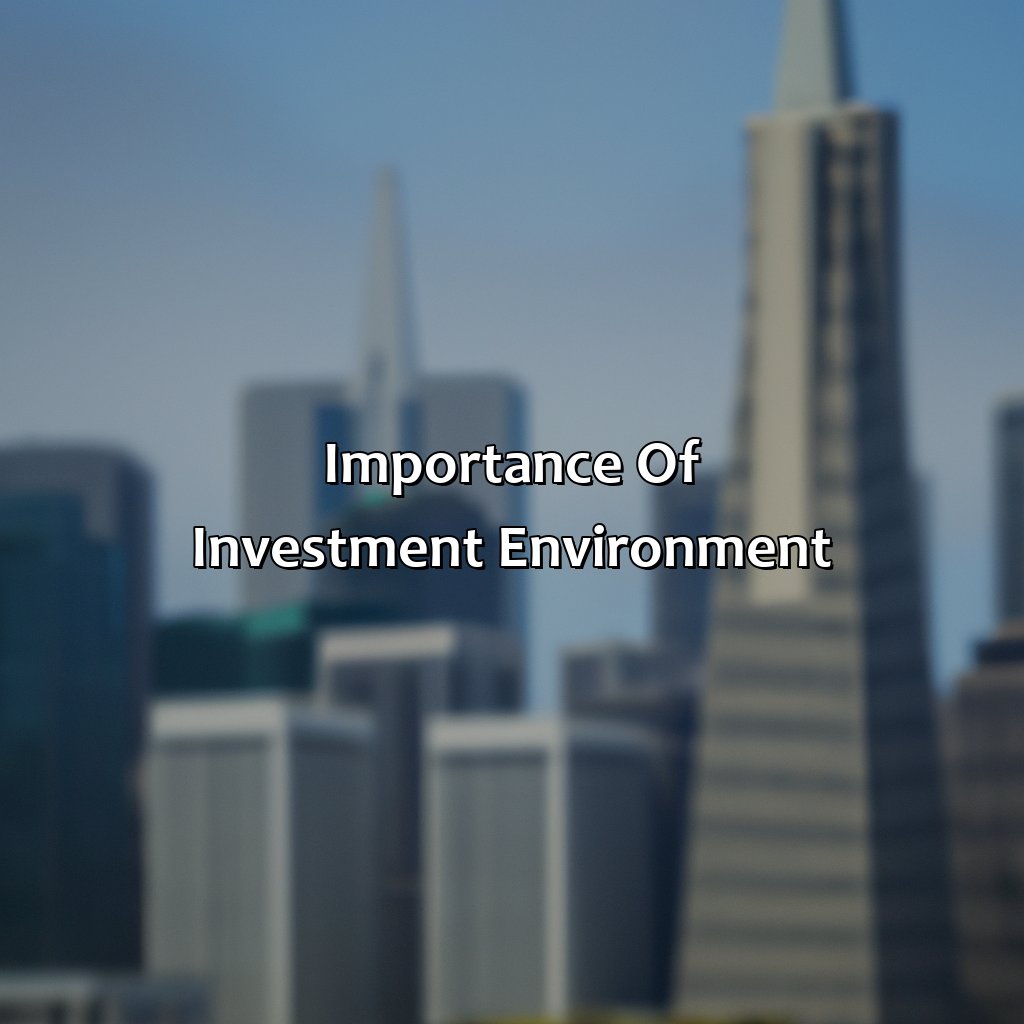
Image credits: retiregenz.com by James Washington
Determines Investment Opportunities
The investment environment is a crucial determinant of the available investment opportunities. Favorable investment environments increase the likelihood of profitable investments while unfavorable ones result in less profitable investments. This means that investors need to assess the environment before deciding on where to invest their money.
Factors that determine the investment environment include economic stability, political stability, tax policies, legal framework, and technological advancement among others. These factors help investors to select areas with favorable policies such as tax incentives or a stable economy thereby reducing risk.
Investors should also consider other environmental factors such as demographic trends and social issues to ensure their investments align with current needs. These factors give insight into potential market demand for products and services required in various geographical locations.
Pro Tip: Monitoring changes in the investment environment can provide vital intelligence needed by investors to identify emerging opportunities leading to successful returns on investments.
Investor confidence is like a Jenga tower, one wrong move and it all falls apart.
Affects Investor Confidence
The investment environment is a crucial aspect for investors, and it heavily impacts their confidence in making investment decisions. The state of the investment environment affects investor behavior, including buying, selling, holding or not participating in the market.
When investors are confident that the investment environment is stable and promising, they are more likely to invest. However, when they feel that the environment is risky or unstable, they tend to hold onto their investments instead of investing further. This lack of confidence can lead to reduced investments and an overall negative impact on the economy.
Factors such as political stability, economic policies, legal framework and infrastructure influence the investment environment. A conducive investment climate nurtures entrepreneurship and drives innovation resulting in a sustainable economic growth which in turn boosts investor confidence leading to higher amount of investments.
It is imperative that governments foster an enabling environment by taking measures such as providing tax incentives, improving governance structures and human capital development are vital.
Putting all your money in the stock market is like playing a game of Russian Roulette, except the gun has 100 chambers instead of 6.
Influences Investment Risk
The surroundings affecting the possibility of a potential return on investment is what characterizes investment environment. Country’s Political stability, government regulations, and natural forces all play an essential role in it. In addition, inflation rates also impact investments.
An unfavorable investment environment with unstable economic conditions make it more risky investing compared to when there is political stability and manageable inflation rates.
In regards to the significance of Investment Environment, selecting the proper market and industry for investment can eventually result in Long-term gains.
Pro tip: Researching political environment and current events in countries before making any decision concerning adding new investments can lead to better decision making.
Choosing the right investment environment is like finding a needle in a haystack – but with the potential for a much bigger payoff.
Factors to Evaluate Investment Environment
For successful evaluation of the investment environment, many aspects should be considered. Government policies, economic indicators, market conditions, social factors and technological advances are key pieces of information to consider. Each one of these is important in forming an overall view of the investment climate. More details about each one will be provided.
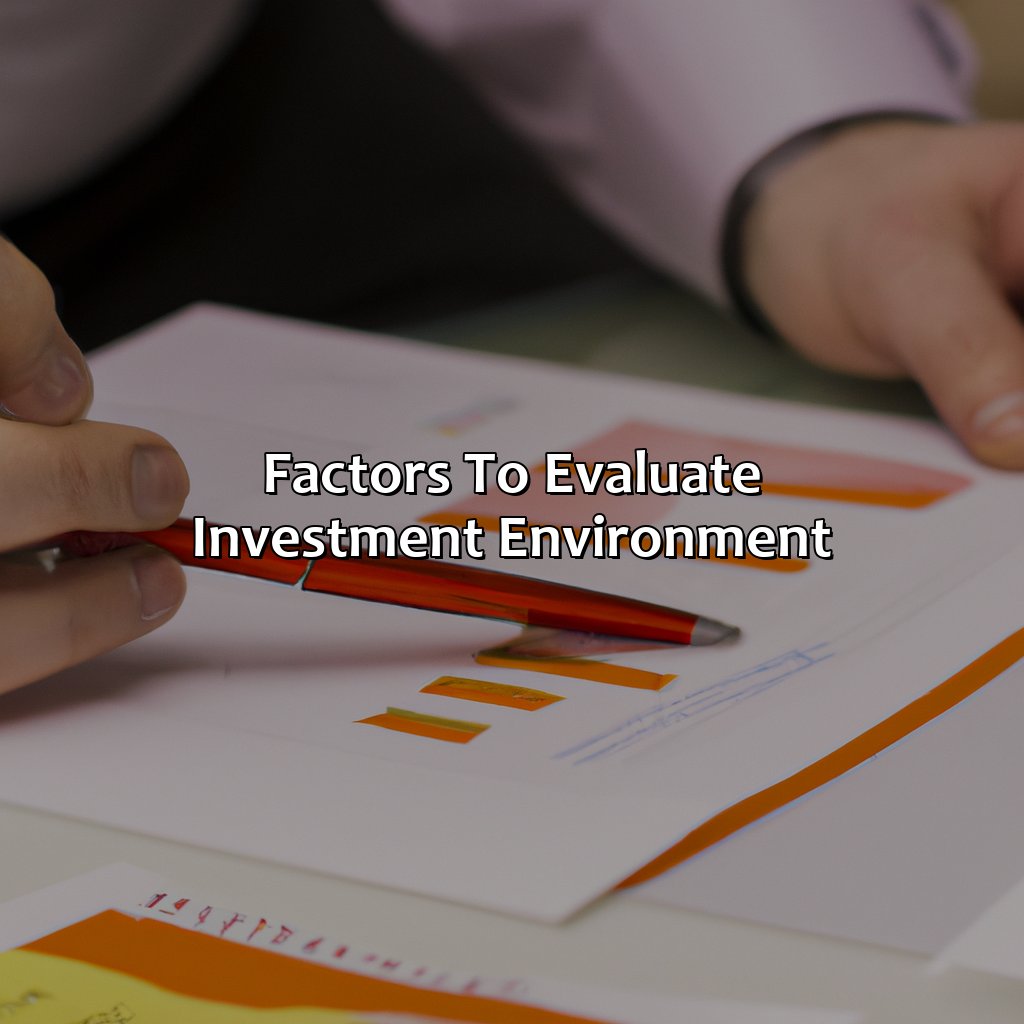
Image credits: retiregenz.com by David Washington
Government Policies
Policies Set by Authorities
The policies set by the authorities play a crucial role in evaluating the investment environment. The investment climate needs to be favorable for investors to pour their capital.
From the setting up of industries and establishing businesses, each policy affects an investor’s decision. Apart from that, the regulatory framework needs to safeguard investor interests while being flexible enough for businesses to thrive.
Moreover, changes and amendments in policies over time can impact investments adversely or favorably. Thus, policymakers need careful consideration of such implications before making any decisions required.
A True Example
A country once initiated new policies offering incentives to manufacturing units. As a result, multinational companies invested heavily in setting up factories there. However, some years later, the government changed drastically and removed all incentives. This resulted in all companies shutting down their operations and leaving behind massive losses for investors who were unable to forecast the stormy government ahead.
“The only thing more unreliable than economic indicators is that friend who always says they’ll pay you back.”
Economic Indicators
Measuring Financial Performance Parameters
Economic indicators help evaluate an investment environment. These are economic statistics that provide insight into a country’s economic situation, giving investors critical information to make investment decisions. GDP, inflation rate, interest rate, and unemployment rate are the most common indicators investors use to analyze an economy.
| Indicator | Description |
| GDP (Gross Domestic Product) | The total value of all goods and services produced in a country over a specified period |
| Inflation Rate | The percentage increase in the price levels of goods and services over time. |
| Interest Rate | The amount charged by lenders to borrowers or paid by banks on deposits that yield interest |
| Unemployment Rate | The proportion of individuals out of work compared to the entire labor force in the country. |
Understanding these parameters can significantly influence financial outcomes since they indicate certain market trends’ health status. The more information an investor has about them, the better their chances of making well-informed investment choices.
It was reported that Chineke, Inc., invested heavily in Europe due to the region’s strong GDP growth rate in recent years. However, after Brexit policy disruptions occurred, many businesses withdrew investments from UK markets, leading Chineke shares’ value to plummet.
Market conditions are like a box of chocolates, you never know what you’re gonna get – but hopefully none of them are filled with economic recession.
Market Conditions
Investment Environment is evaluated by analyzing the circumstances affecting investment decisions. Market dynamics, political stability, economic indicators and legal aspects are vital components of it. Market Conditions refer to an important aspect of evaluating the Investment Environment. It focuses on market statistics such as supply and demand, pricing trends, competition level, consumer behavior, and key players’ performance. These factors significantly impact the business success rate, investment opportunity identification and assessment.
Market fluctuations cause investors to make strategic decisions based on real-time data analysis of varying market conditions rather than solely relying on historical data. Moreover, monitoring market indicators can help investors identify risks or opportunities for financial gain in specific industry sectors or geographical locations that can aid the decision-making process better.
Amidst severe trade tensions between China and the United States over intellectual property infringement concerns, Chinese Foreign Minister Wang Yi accentuated that his country’s stance against international arbitration in settling disputes. UN Charter principles imply peaceful resolution of these issues where states take full responsibility for their actions to abide by these rules.
According to Forbes magazine’s article “5 Key Factors That Affect Foreign Direct Investment (FDI),” published on 25 Dec 2020.
- Political climate in host country and region
- Market size and potential
- Infrastructure
- Legal and regulatory environment
- Culture, language, and workforce skills
“Investing in a society where everyone’s goal is to win the lottery is like betting on a one-legged horse in a race.”
Social Factors
The cultural and societal norms of a region make up a vital element when analyzing the investment environment. Social factors play an imperative role in determining customer behavior towards new products and services, creating awareness about them, and seizing the opportunities for businesses. The general attitude towards entrepreneurship, income distribution, education level, population composition, religion, lifestyle choices – all constitute social factors that describe the investment environment.
Furthermore, the consumption habits are impacted by social factors as well. Their impact on purchases translates into evaluating an analysis relevant to various business sectors like FMCG sectors or cosmetic products. The correlation between social factors affects multiple industries ranging from advertising to designing strategies for healthcare facilities. Understanding these elements is necessary to develop a successful investment plan tailored for specific regions.
It is fascinating to note that during World War II, women entered the workforce en masse to replace men who were sent to war fronts. This move single-handedly brought a significant change in America’s society and economics impacting labor markets worldwide- affecting companies with exclusive male employee policy positively leading firms to drop their discrimination policies based on gender identity.
Technological Advancements
In today’s investment environment, it is crucial to consider the impact of technological innovations. The rapid pace of change in AI, data analytics and blockchain are just some examples that need to be evaluated for their potential impact on investments. These advancements have disrupted many industries, and a comprehensive understanding of the technology landscape is essential for successful decision-making. Such insights can help investors anticipate market trends and stay ahead of the competition.
Moreover, technological advancements have also led to greater efficiency and productivity across various sectors. For example, automation has reduced manual errors and cut down on time-consuming tasks, resulting in more cost-effective operations. Robust cybersecurity measures implemented by companies have led to better protection against cyber-attacks which are becoming increasingly sophisticated. Furthermore, advanced data analytics software has made it possible for quantitative investors to process large volumes of data in real-time with greater accuracy.
It is important for investors to note that as technology continues to evolve at a rapid rate, it may lead to certain risks such as cybersecurity threats and obsolescence risks associated with depreciating assets. Thus, investors should conduct thorough due diligence before investing in any technology-related firm.
A study by Deloitte found that 85% of companies surveyed believed that artificial intelligence would become a “strategic priority” within two years. With this trend not showing any signs of slowing down soon, investors who are able to spot opportunities early will likely be better positioned for success in the long run.
Some Facts About Investment Environment:
- ✅ The investment environment refers to all the factors that can affect investments, including economic, political, and social conditions. (Source: Investopedia)
- ✅ The performance of the stock market is a key indicator of the investment environment. (Source: The Balance)
- ✅ Interest rates, inflation, and tax policies are important factors in creating a favorable investment environment. (Source: Forbes)
- ✅ The level of risk in the investment environment affects the type of investments people are willing to make. (Source: Investopedia)
- ✅ A stable investment environment can encourage foreign investments and promote economic growth. (Source: World Bank)
FAQs about What Do You Mean By Investment Environment?
What do you mean by investment environment?
Investment environment refers to the set of external factors that affect the performance of investments, such as economic conditions, political stability, inflation, interest rates, and market trends.
How does the investment environment affect investment decisions?
The investment environment can significantly impact investment decisions as it affects the returns on investments and the level of risk involved. Investors are more likely to invest when economic conditions are stable, inflation is low, and interest rates are favorable. On the other hand, political instability and unpredictable market trends can discourage investors from making investments.
What are some factors that determine the investment environment?
The investment environment can be determined by factors such as government policies, economic conditions, market trends, demographic changes, and technological advancements. These factors can have a significant impact on the performance of investments, and thus, investors need to keep a close eye on them.
Why is it essential to understand the investment environment?
Understanding the investment environment is crucial for making informed investment decisions. It helps investors identify potential risks and opportunities and adjust their strategies accordingly. A good understanding of the investment environment is also crucial for formulating long-term investment plans and managing investments effectively.
How can an investor adapt to a changing investment environment?
To adapt to a changing investment environment, investors need to stay informed and up-to-date on economic and market trends, government policies, technological advancements, and demographic changes. They need to be flexible and willing to adjust their investment strategies based on new developments and changing circumstances. Diversifying investments can also provide a buffer against any unexpected changes in the investment environment.
Can the investment environment be predicted?
The investment environment is complex and can be challenging to predict accurately. Though some indicators, such as economic forecasts and market trends, can provide valuable insights, they are not always reliable. The best approach for investors is to remain vigilant and flexible and be prepared to adjust their investment strategies as the investment environment changes.
